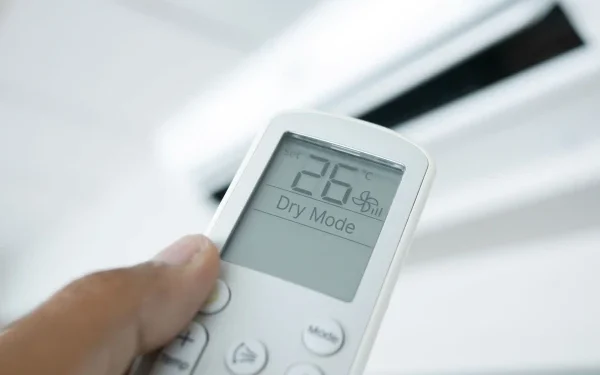Air conditioners have become a staple in homes and offices, especially in regions experiencing intense heat and humidity. While most users are familiar with the “Cool Mode” of an AC, very few understand the significance and benefits of the “Dry Mode” — a feature that not only improves comfort but also helps reduce electricity bills significantly.
This article will explore in detail what dry mode is, how it works, when to use it, and how it can result in substantial energy savings.
Understanding Dry Mode in Air Conditioners
### 🔹 What is Dry Mode?
Dry mode is a function found in many modern air conditioners, designed to reduce the humidity level in a room rather than directly cooling the space. It is especially effective in tropical or coastal regions where high humidity is a problem, even when temperatures are relatively moderate.
When you switch your AC to dry mode, the unit works to dehumidify the air, which results in a more comfortable environment without excessively lowering the temperature.
🔹 How Does Dry Mode Work?
The air conditioner’s compressor plays a key role in dry mode but operates differently than in the regular cooling mode. Here’s a simplified breakdown of how it functions:
- The compressor turns on and off intermittently, instead of running continuously like in cooling mode.
- The fan inside the unit runs at a low speed, drawing in the humid air from the room.
- The moisture in the air condenses on the AC’s evaporator coil, turning into water.
- This collected water is drained outside through the AC’s drainage system.
- As the humidity is reduced, the room feels cooler and more comfortable even though the actual temperature hasn’t dropped significantly.
Unlike cooling mode, dry mode doesn’t aim to lower the room temperature drastically — its primary goal is to make the air less muggy and easier to breathe.
Difference Between Dry Mode and Cool Mode
| Feature | Dry Mode | Cool Mode |
|---|---|---|
| Purpose | Dehumidification | Temperature reduction |
| Compressor usage | Intermittent | Continuous |
| Fan speed | Low | Medium to high |
| Power consumption | Lower | Higher |
| Suitable climate | Humid but mild temperatures | Hot and dry or hot and humid |
Many people mistake dry mode for just a weaker version of cool mode, but it serves a completely different purpose. While cooling mode tries to reach and maintain a specific temperature, dry mode tries to balance moisture levels in the air.
How Dry Mode Helps in Reducing Electricity Bills
One of the most attractive advantages of using dry mode is its potential to lower your electricity consumption. Here’s how it helps:
🔹 Reduced Compressor Operation
In cool mode, the compressor runs continuously to maintain the desired room temperature, which consumes a large amount of electricity. In contrast, dry mode uses the compressor intermittently, leading to significantly lower power consumption.
🔹 Limited Cooling Demand
Since dry mode doesn’t aim to reduce the temperature drastically, less energy is needed to run the system, making it a cost-effective option for comfort in humid weather.
🔹 Estimated Energy Savings
It is estimated that by using dry mode on days with high humidity and moderate temperatures, you can reduce electricity usage by 30% to 50% compared to regular cooling mode. This makes a noticeable difference in monthly electricity bills, especially during the monsoon season or in coastal cities.
When Should You Use Dry Mode?
Dry mode is not suitable for all weather conditions. It is most beneficial when:
- The temperature is not extremely hot, but the humidity is high.
- During rainy or monsoon seasons, when the moisture level is unbearable.
- In early mornings or late evenings, when cooling isn’t necessary, but dehumidification improves comfort.
- If your room feels sticky or clammy, even when it’s not particularly hot.
Using dry mode in very hot conditions may not be effective, as it won’t cool the room sufficiently. For such situations, cool mode remains more suitable.
Benefits of Using Dry Mode Beyond Cost Savings
While saving on your energy bill is a major benefit, dry mode offers several other advantages that enhance your living environment.
✅ Improved Air Quality
High humidity fosters the growth of mold, bacteria, and dust mites. By reducing moisture in the air, dry mode helps improve air hygiene, especially beneficial for people with allergies or asthma.
✅ Better Sleep Environment
Sleeping in a humid room can be uncomfortable and sweaty. Dry mode offers a more breathable and pleasant environment, without overcooling — which is common with regular AC modes.
✅ Reduced Wear and Tear
Lower compressor usage means less stress on AC components, potentially extending the lifespan of the unit and reducing the need for maintenance.
Tips for Maximizing the Benefits of Dry Mode
To make the most of dry mode, consider the following:
- Use a Hygrometer: A simple device that tells you the humidity level in your room. Ideally, indoor humidity should be between 30% and 50%.
- Seal the Room: Make sure windows and doors are properly closed so that humid air from outside doesn’t keep entering.
- Don’t Overuse It: Dry mode is most effective for moderately humid conditions, not extreme temperatures.
- Combine with Ceiling Fan: Running a ceiling fan can help circulate dry air, improving comfort without additional energy costs.
- Clean Filters Regularly: A clogged air filter can reduce the efficiency of the AC in any mode, including dry mode.
Popular AC Brands That Offer Dry Mode
Most modern air conditioning brands include dry mode in their standard remote control features. Leading brands like:
- Daikin
- Mitsubishi
- LG
- Haier
- Samsung
- Gree
- Panasonic
have integrated smart controls to automatically adjust fan speed and compressor operation in dry mode, offering user-friendly options for energy savings.
Conclusion: Small Change, Big Savings
Understanding and using the Dry Mode in your air conditioner is a smart move — both environmentally and financially. For people living in humid climates, it’s a feature that can enhance comfort while lowering your electricity bill. It offers a practical solution for days when humidity is the real culprit behind discomfort rather than just the heat.
By using dry mode appropriately, homeowners and businesses alike can benefit from energy efficiency, improved indoor air quality, and long-term cost savings. So, the next time the air feels muggy but not hot, try switching your AC to dry mode — your comfort and your wallet will thank you.

























